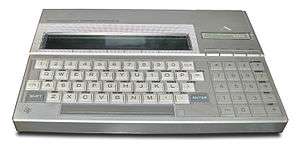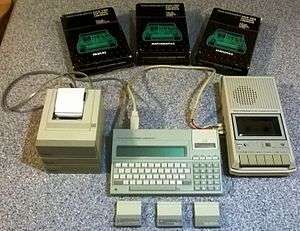Texas Instruments Compact Computer 40
 | |
| Type | Home computer |
|---|---|
| Release date | March 1983 |
| CPU | TMS70C20 @ 2.5 MHz |
| Memory | 6 KB |
The Texas Instruments Compact Computer 40 or CC-40 is a battery-operated portable computer that was manufactured and released by Texas Instruments in March 1983. Priced at US$249, it weighs 600 grams (22 ounces) and can be powered by four AA batteries or an AC adapter. It was intended as a portable business computer, and uses TI's TMS70C20 CPU, an 8-bit microprocessor that ran at 2.5 MHz.
The CC-40 has 6 kilobytes of on board Random Access Memory (expandable to 18 KB), 34 KB of Read Only Memory, and a 31-character LCD display. It is capable of operating for 200 hours off one set of batteries, and memory is not erased by powering the unit off, so an unpowered unit can retain data for several months.
A digital "wafertape" unit (a licensed version of the Exatron Stringy Floppy)[1] depicted on the computer's box was only released as a prototype, reportedly because it proved too unreliable. No disk or tape drive was released with the unit. The inability to store data permanently hurt the CC-40's sales. The CC-40 does have a single Hexbus port for connecting peripherals. The following Hexbus peripherals were developed: 80 column printer, printer/plotter, RS232, Modem, Wafertape (unreleased), Video Interface (unreleased), 5.25 Floppy Disk Drive (unreleased). Expansion was to be through a Hexbus interface, arguably prototypical to USB, providing Hot swapping plug-and-play functionality. The HexBus interface was also available for the TI-99/4A and was built into the prototype-only TI-99/2 and TI-99/8.
An improved model, the CC-40 Plus, was in the final stages of development. The Plus featured a cassette port, but the project was canceled when Texas Instruments canceled the 99/4A and left the home computer field.
 | |
| Type | Home computer |
|---|---|
| Release date | Never Released |
| CPU | TMS75305 (TMS70C20 variant) |
| Memory | 18 KB |
Also in development was the Compact Computer 80 or CC-80. The CC-80 (80 Column Display) was to have four cartridge ports, more RAM and an 8x80 display with graphics capability. Work was 99% complete when TI left the market. However, some of the work completed on the CC-80 was later revived in the TI-74 BASICALC.
Software was only available on cartridge, or by typing simple programs into its built-in BASIC interpreter. The BASIC interpreter is similar but not identical to the TI-99/4A.
Reception
BYTE heavily criticized the CC-40; "there's no clock. No file system. Only one BASIC program at a time can reside in memory, and the user can only work with about 5200 bytes of that. And the keyboard is vile". It also noted the lack of any external storage because the TI wafertape drive was not available, and the complete lack of software. The review suggested that the computer should be considered a "dandy scientific calculator" since good programmable calculators cost about the same as the CC-40's $250 price, but that otherwise "virtually all of its competition vastly outstrips it in power and features", including the $99 TI 99/4A.[2]
References
- Thomas, David (1983). Learn BASIC: A Guide to Programming the Texas Instruments Compact Computer 40. Texas Instruments, Inc. and McGraw Hill, Inc. ISBN 0-07-064257-5.
- ↑ Halfhill, Tom R. (July 1983). "Exatron Stringy Floppy for VIC-20 and 64". Compute!'s Gazette. pp. 58–62. Retrieved 6 February 2016.
- ↑ Ramsey, David (September 1983). "Epson's HX-20 and Texas Instruments' CC-40". BYTE. p. 193. Retrieved 20 October 2013.